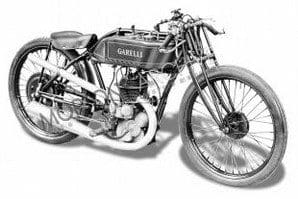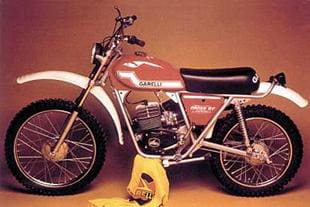
Gadabout 1946-51 UK
See Swallow, scooters built by famous sidecar maker.
Gaia 1922-32 Italy
Turin maker of lightweights with Moser, Rubinelli and Ladetto and Blatto engines. Rare.
Galbusera 1934-55 Italy
Production began with a range of ohv singles using Italian Miller engines (Rudge units built under licence). Galbusera sensationally unveiled prototype examples of a 250 V-four and 500cc V-eight at the 1938 Milan Show. Both capacity engines were designed with the supercharged engine in line with the frame. Post-WWII production comprised 75-175cc Sachs two-stroke engined models plus larger capacity four-strokes, often assembled using left over pre-WWII engines. The pre-WWII ohv four-strokes are sought after.
Galloni 1920-31 Italy
Manufacture started with 494cc and 744cc side-valve V-twin models. Then a range of side-valve and ohv 250cc -500cc singles which shared many cycle parts with the V-twins. Their frames were of conventional design except they sported a form of rear suspension. Despite diversifying to install proprietary engines, the firm folded in 1931, another victim of the worldwide depression.
Gamage 1903-24 UK
London based chain of stores who sold motorcycles under their ‘house’ label, built variously by established motorcycle makers including Omega and Radco.
Gaoma 1953-55 Italy
Officine Gaoma of Milan built lightweight scooters with 18in wheels and 65/75cc two-stroke engines.
Garabello 1906-29 Italy
Leading pioneer Italian motorcycle manufacturer Francesco Garabello, an innovative designer, launched a range of 250-500cc side-valve singles in 1906. A shaft-drive water cooled 1000cc in-line four was unveiled in 1920, followed by a water-cooled shaft-drive 175cc overhead rotary valve single. Francesco was an important figure in the Italian motorcycle scene for two decades.
Garanzini 1921-31 Italy
Successful racing motorcyclist Oreste Garanzini imported the British made Verus (Veros for the Italian market) then began making his own motorcycles in 1921 using Blackburne, Villiers and JAP engines. Racing played an important role in Oreste’s life. In 1926 he patented a front fork and often heavily modified ‘bought in’ engines to ohc, three-valve cylinder heads and oil cooling. Yet another victim of the worldwide depression. A rare find.
 Garelli 1919- Italy
Garelli 1919- Italy
University trained engineer Adalberto Garelli perfected his two-stroke engine design while working for car giants Fiat, who sadly didn’t share his two-cycle beliefs, so he left in 1911 to build his first prototype 350cc split single two-stroke motorcycle. As a publicity stunt Garelli rode the machine in January 1914 to the top of the Moncenisio Pass, 6316ft above sea level, in driving snow and sub zero temperatures. The feat was duly witnessed and verified by Capitano Carlo Constrada, the commander of the barracks at the top of the pass.
Spells of employment with Bianchi and Stucchi left Adalberto frustrated, but continuing success in Army organised trials with his split singles convinced him to establish a motorcycle factory. The first 350cc two-stroke Garellis left his Sesto San Giovanni – near Milan – factory in 1919. To create publicity, his factory team riders Erminio Visioli, Ernesto Gnesa and Ottorino Dall’Oglio entered every race of note in Italy, as well as some in neighbouring countries. Often unbeatable in the 350cc class, the 350cc split single regularly gave a good account of itself in the 500cc class too.
Quitting road racing at the end of the 1924 season – while ahead of the game – Garelli had embarked on a new form of publicity stunts, World Records. In one session at Monza in 1923 Garelli scooped 76 records and in 1926 grabbed 193 world records – itself another world record! During the late Twenties, Garelli began to run down motorcycle manufacture in favour of other engineering work. From 1935-47 the factory abandoned motorcycles totally.
After WWII, Garelli spotted a huge market for cheap personal transport and began production of the 38cc two-stroke Mosquito clip-on unit. Fitted under the pedal crank of a bicycle, it drove the rear wheel by a roller pressed on the tyre. These units were built under licence by other factories, including Chapius from whom a team of riders covered 24,964 miles in 55 days on a single machine. During the Fifties and Sixties, Garelli continued with world speed record sprees.
In 1952 the 400,000th Mosquito was built and, three years later, Garelli enlarged the Mosquito to 49cc, fitted a centrifugal clutch and installed it in a moped frame. It was their first complete machine for 20 years. Business links with giant Italian cycle component makers Agrati in the late Fifties, led to a merger in 1961. Production lines were streamlined at the Sesto San Giovanni factory, enabling Garelli to expand their share of the home ultra lightweight motorcycle market, while Agrati continued with cycle parts and Capri scooter manufacture.
Always ahead of the moped and lightweight game, Garelli launched their KL100 series of 80cc roadsters and trail models with electronic ignition in the early Seventies. The ultra popular 50cc Tiger Cross trail model was also introduced, along with the Record and Cross Special. New UK legislation for 1972 restricted 16-year-olds to 50cc mopeds with pedals and the 50mph Tiger Cross was one of ‘the’ machines with the all-important ‘street cred.’ British laws constantly alter and from 1978, all new mopeds were restricted to 30mph.
The Garelli Tiger Cross is now one of the period ‘sports mopeds’ to own – showing politicians can’t keep a good machine down for long! Conventional automatic moped production continued. Models included the Katia, Eureka and Bitmatic.
 They re-entered the road race scene with a 50cc single and 47bhp 124.7cc twin (originally designed for Minarelli by Jorge Moller, but reworked by Garelli engineers), housed in a monocoque chassis in 1982. Garelli scooped six consecutive 125cc riders’s championships (Angel Neito 1982, 1983 and 1984; Fausto Gresini 1985 and 1987 and Luca Cadalora 1986). Despite these successes, the reintroduction of the Mosquito clip-on in 1985, a 250cc V-twin road racer and the 323 trials plus the regular moped and lightweight models, company fortunes were slipping. Agrati reverted to cycle work and by the 1991 Milan Show Garelli had been taken over by Fantic to exist as a badge name alone.
They re-entered the road race scene with a 50cc single and 47bhp 124.7cc twin (originally designed for Minarelli by Jorge Moller, but reworked by Garelli engineers), housed in a monocoque chassis in 1982. Garelli scooped six consecutive 125cc riders’s championships (Angel Neito 1982, 1983 and 1984; Fausto Gresini 1985 and 1987 and Luca Cadalora 1986). Despite these successes, the reintroduction of the Mosquito clip-on in 1985, a 250cc V-twin road racer and the 323 trials plus the regular moped and lightweight models, company fortunes were slipping. Agrati reverted to cycle work and by the 1991 Milan Show Garelli had been taken over by Fantic to exist as a badge name alone.
Gazelle 1903-58 Holland
Famous Deiren cycle manufacturer who built Sarolea engined motorcycles, then after a break of over two decades introduced in 1932 a range of Ilo and later Villierspowered lightweights. Entered the clip-on market c1935 with an electric motor attachment for cycles. After WWII, assembled mopeds with propriety engines.
Geco-Herstal 1925-28 France
Establishments Gerkinet & Co (Geco) built their own motorcycles and assembled Gillets for the famous Herstal, Belgium factory. French built Gillets surface at Continental shows.
Geier 1934-39 and 1950-54 Germany
Cycle maker from Lengerich who made 73-98cc two-stroke lightweights and autocycles beforeWWII. From 1950, they introduced an extensive range of 98-174cc Ilo and Sachs engined lightweights and the Motri (half motorcycle, half pick-up truck).


